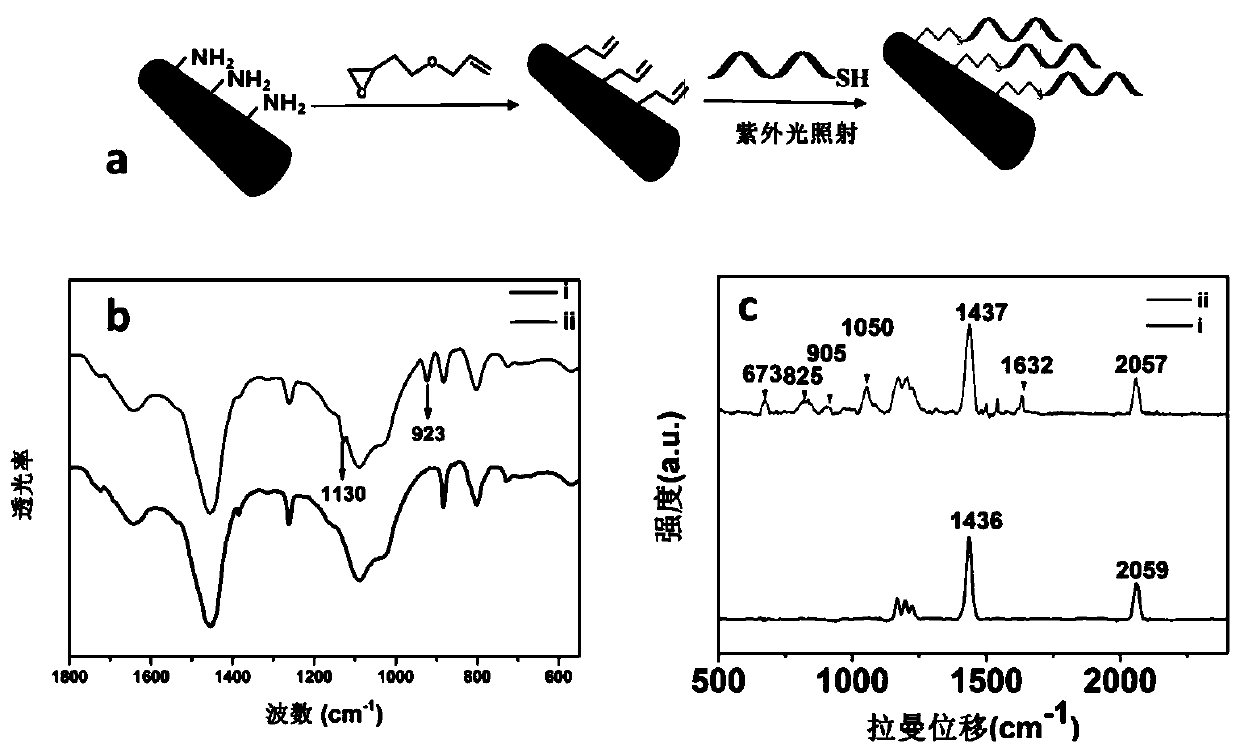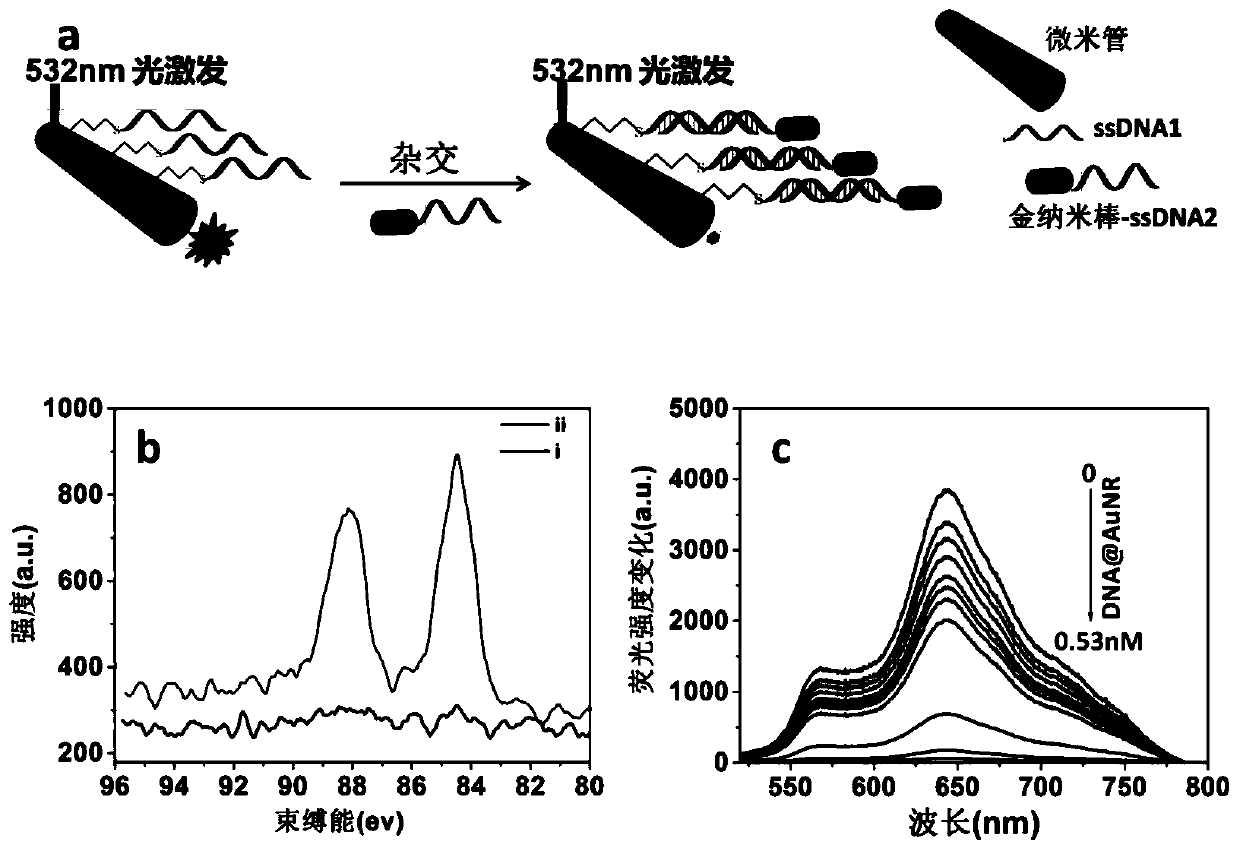A method, probe set and kit for detecting miRNAs-21
A miRNA-21, kit technology, applied in the field of molecular biology, can solve the problems of high sequence similarity, low stability, photobleaching, etc., and achieve the effect of high sensitivity and selection
- Summary
- Abstract
- Description
- Claims
- Application Information
AI Technical Summary
Problems solved by technology
Method used
Image
Examples
preparation example Construction
[0035] The preparation method of the polydiacetylene microtube of the present invention is specifically as follows: take 0.0056g of aminodiacetylene and 0.00075g of octadecylamine-substituted melamine and dissolve it in 2mL of absolute ethanol solution, and pour the solution into a 300mL ultra- In pure water, sonicate for 60 minutes, place in a dark place to cool naturally to room temperature, and then put in a refrigerator at 4°C overnight to obtain complex vesicles. Add 10ml of vesicle solution and 10μL of lead nitrate solution to the weighing bottle, open it at room temperature and place it in a ventilated place. After two to three weeks, white filamentous substances will precipitate, and polydiacetylene microtubes will be obtained.
[0036] In some embodiments, the preparation method of the polydiacetylene microtube modified by single-stranded DNA of the present invention is specifically: the polydiacetylene microtube is taken out from the weighing bottle, placed under a 25...
Embodiment 1
[0053] Example 1: Preparation of single-stranded DNA modified microtubes
[0054] Dilute 20 μL of allyl glycidyl ether to 10 mL, add polydiacetylene microtubes, and react overnight at 30° C. to obtain double bond-modified polydiacetylene microtubes. Combine a single polydiacetylene microtube with 200 μL of 5'-end thiol-modified single-stranded DNA (ssDNA1 sequence shown in SEQ ID NO: 1), 2959 photoinitiator (n(2959):n(ssDNA1)=1: 100) Mix evenly and react under 365nm light for 6 hours to obtain single-stranded DNA modified polydiacetylene microtubes. The microtube infrared spectrum of single-stranded DNA modified polydiacetylene microtubes is shown in figure 2 b, Raman spectrum of polydiacetylene microtubes modified with single-stranded DNA see figure 2 c.
Embodiment 2
[0055] Example 2: Single-stranded DNA modified gold nanorods
[0056] Gold nanorods were prepared by the seed growth method, and after purification, they were incubated with 5'-end thiol-modified single-stranded DNA (ssDNA2 sequence shown in SEQ ID NO: 2) (the molar ratio of gold nanorods to DNA was 1:25600) , to obtain single-stranded DNA modified gold nanorods. The specific operation is as follows: first, add 250 μL of 0.01 M chloroauric acid to 7.5 mL of 0.1 M cetyltrimethylammonium bromide (CTAB) solution, and stir evenly. Then 600 μL of 0.01 M sodium borohydride solution was added (sodium borohydride was placed at -20° C. for 10 minutes in advance), and then stirred for 2 minutes under mechanical stirring (400 rpm). After 2 minutes, a light brown solution will form, which is the gold seed solution. The gold seed solution should be left at room temperature for 1 hour before use. Preparation of growth solution: under mechanical stirring conditions (stirring speed is 250r...
PUM
 Login to View More
Login to View More Abstract
Description
Claims
Application Information
 Login to View More
Login to View More - R&D
- Intellectual Property
- Life Sciences
- Materials
- Tech Scout
- Unparalleled Data Quality
- Higher Quality Content
- 60% Fewer Hallucinations
Browse by: Latest US Patents, China's latest patents, Technical Efficacy Thesaurus, Application Domain, Technology Topic, Popular Technical Reports.
© 2025 PatSnap. All rights reserved.Legal|Privacy policy|Modern Slavery Act Transparency Statement|Sitemap|About US| Contact US: help@patsnap.com



